The buried leak detector market is projected to reach USD 149.6 million in 2025 and expand to USD 236.9 million by 2035, reflecting a compound annual growth rate (CAGR) of 4.7%. Growth in this sector is being driven by the increasing need for efficient detection of underground pipeline leaks in water supply, oil and gas, and utility networks. Buried leak detectors enhance operational safety, reduce wastage, and support compliance with regulatory frameworks focused on sustainability and resource management. As governments and industries prioritize infrastructure integrity and environmental protection, the adoption of buried leak detection technologies is expected to accelerate steadily over the forecast horizon.
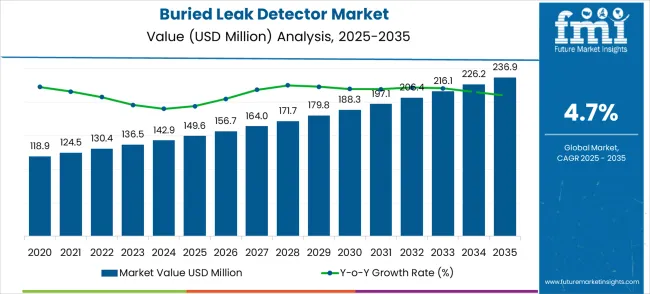
| Metric | Value |
|---|---|
| Market Value (2025) | USD 149.6 million |
| Market Forecast Value (2035) | USD 236.9 million |
| Market Forecast CAGR (2025–2035) | 4.7% |
A closer look at market drivers shows the growing role of smart technologies and infrastructure monitoring in shaping expansion. Year-on-year growth indicates a consistent rise, from USD 118.9 million in 2023 to USD 149.6 million in 2025, continuing with steady increments throughout the decade. Deployment of sensors, IoT-enabled leak detection systems, and advanced acoustic monitoring tools are expanding the application scope. Utilities are increasingly investing in predictive maintenance and real-time monitoring solutions to reduce financial losses and environmental risks. This integration of technology with traditional detection methods is enhancing reliability and efficiency, further pushing the buried leak detector market upward.
Looking ahead, the buried leak detector market is expected to reach USD 188.3 million by 2030 and eventually USD 236.9 million by 2035, with a CAGR of 4.7%. Growth contribution index analysis suggests that adoption in municipal water management and oil and gas infrastructure will be the primary contributors to expansion, while incremental demand from industrial utilities will add further stability. Each sector contributes proportionally to overall market momentum, ensuring consistent long-term value creation. Although growth is moderate, its sustainability highlights the critical importance of leak detection technologies in resource conservation, infrastructure resilience, and environmental safety.
Market expansion is being supported by the rapid increase in aging infrastructure challenges worldwide and the corresponding need for proactive monitoring systems that provide superior leak detection performance and cost-effective maintenance solutions. Modern infrastructure applications rely on advanced detection technologies to ensure optimal system reliability including water distribution networks, oil and gas pipelines, and industrial process systems. Even minor leak incidents can require comprehensive infrastructure repair adjustments to maintain optimal operational standards and environmental compliance.
The growing complexity of underground infrastructure requirements and increasing demand for real-time monitoring solutions are driving demand for buried leak detector equipment from certified manufacturers with appropriate sensing capabilities and monitoring expertise. Infrastructure operators are increasingly requiring documented detection sensitivity and system reliability to maintain operational efficiency and regulatory compliance. Industry specifications and safety standards are establishing standardized monitoring procedures that require specialized detection technologies and validated alert systems.
The Buried Leak Detector market is entering a new phase of growth, driven by demand for infrastructure monitoring, smart city development, and evolving regulatory and sustainability standards. By 2035, these pathways together can unlock USD 30-40 million in incremental revenue opportunities beyond baseline growth.
Pathway A -- Water Infrastructure Modernization Water distribution and sewage systems represent the largest opportunity due to aging infrastructure and conservation mandates. Smart water networks requiring continuous monitoring drive premium segment growth. Opportunity pool: USD 10-12 million.
Pathway B -- Oil & Gas Pipeline Expansion Energy infrastructure growth in emerging markets presents significant opportunities. Advanced detection systems for oil and gas pipelines with environmental compliance requirements offer premium positioning. Opportunity pool: USD 8-10 million.
Pathway C -- Smart City Integration IoT-enabled monitoring systems integrated with city management platforms present expanding opportunities. Connected infrastructure monitoring for multiple utility types can capture cross-sector growth. Opportunity pool: USD 6-8 million.
Pathway D -- Emerging Market Infrastructure Development Asia-Pacific, Middle East, and Latin America present growing demand due to infrastructure expansion. Local partnerships and affordable detection solutions will accelerate adoption. Opportunity pool: USD 4-6 million.
Pathway E -- Chemical and Industrial Applications Chemical transport pipelines and industrial process systems offer secondary growth opportunities. Specialized detection systems for hazardous materials provide premium market segments. Opportunity pool: USD 3-4 million.
Pathway F -- District Energy Systems District heating and cooling networks represent growing opportunities. Specialized detectors for thermal distribution systems capture expanding renewable energy infrastructure markets. Opportunity pool: USD 2-3 million.
Pathway G -- Predictive Maintenance Services Comprehensive monitoring services with predictive analytics create recurring revenue streams while providing enhanced value to infrastructure operators. Opportunity pool: USD 2-2.5 million.
Pathway H -- Environmental Compliance Solutions Specialized detection systems for environmental protection and regulatory compliance offer niche premium opportunities for sensitive environmental areas. Opportunity pool: USD 1-2 million.
The market is segmented by equipment type, application, and region. By equipment type, the market is divided into acoustic testing equipment, pressure testing equipment, and optical testing equipment. Based on application, the market is categorized into oil & gas pipelines, water distribution and sewage systems, chemical transport pipelines, district heating and cooling, and fire suppression piping networks. Regionally, the market is divided into North America, Europe, East Asia, South Asia & Pacific, Latin America, and Middle East & Africa.
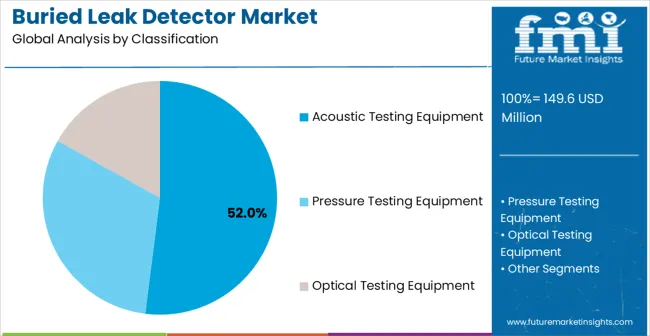
In 2025, the acoustic testing equipment segment is projected to capture around 52% of the total market share, making it the leading detection technology category. This dominance is largely driven by the widespread adoption of acoustic monitoring systems that deliver superior leak detection sensitivity and non-invasive monitoring capabilities, catering to a wide variety of underground pipeline applications. The acoustic testing approach is particularly favored for its ability to provide continuous monitoring and early leak detection while maintaining operational flexibility and cost-effectiveness, ensuring comprehensive coverage. Utility operators, pipeline companies, municipal systems, and industrial facilities increasingly prefer this detection method, as it meets monitoring requirements without compromising system operation or installation complexity. The availability of well-established acoustic sensor technologies, along with comprehensive data analysis software and real-time alert systems from leading manufacturers, further reinforces the segment's market position. Additionally, this technology category benefits from consistent performance across diverse pipeline materials, as it is considered a versatile monitoring solution for facilities requiring reliable detection capabilities. The combination of detection sensitivity, operational flexibility, and cost-effectiveness makes acoustic testing equipment a preferred choice, ensuring its continued dominance in the buried leak detection market.
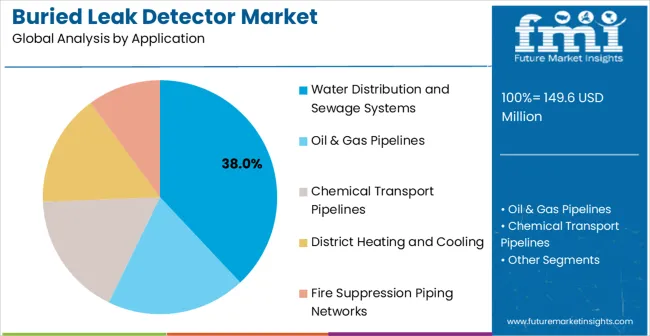
The water distribution and sewage systems segment is expected to represent 38% of buried leak detector demand in 2025, highlighting its position as the most significant application sector. This dominance stems from the unique requirements of municipal water infrastructure environments, where leak prevention and water conservation are critical to operational success and regulatory compliance. Water distribution applications often feature extensive underground networks that demand reliable monitoring systems with proven performance throughout diverse environmental conditions. Buried leak detectors are particularly well-suited to these environments due to their ability to provide continuous monitoring and rapid leak identification effectively, even across large distribution networks. As municipal water systems expand globally and emphasize conservation standards, the demand for leak detection systems continues to rise. The segment also benefits from heightened regulatory focus within the water utility industry, where operators are increasingly prioritizing water loss reduction and system integrity as key performance indicators to ensure operational efficiency and regulatory compliance. With water utilities investing in smart infrastructure and loss prevention programs, buried leak detectors provide an essential solution to maintain high-performance water distribution. The growth of aging infrastructure replacement programs, coupled with increased focus on water resource conservation, ensures that water distribution and sewage systems will remain the largest and most stable demand driver for buried leak detectors in the forecast period.
The Buried Leak Detector market is advancing steadily due to increasing infrastructure maintenance requirements and growing recognition of proactive monitoring advantages over reactive repair strategies. However, the market faces challenges including complex installation procedures in existing infrastructure, need for specialized calibration for different soil and environmental conditions, and varying utility budgets across different geographic regions. Technology advancement efforts and sensitivity improvement programs continue to influence equipment development and market adoption patterns.
The growing development of advanced multi-sensor detection systems is enabling superior monitoring performance with improved accuracy and enhanced environmental adaptability. Enhanced integration technologies and optimized sensor fusion provide superior leak detection results while maintaining cost-effectiveness requirements. These technologies are particularly valuable for utility operators who require reliable detection performance that can support extensive infrastructure monitoring with consistent results.
Modern buried leak detector manufacturers are incorporating advanced IoT connectivity and smart monitoring improvements that enhance data accessibility and response time efficiency. Integration of cloud-based analytics systems and optimized alert management enables superior operational insights and comprehensive infrastructure monitoring capabilities. Advanced IoT features support operations in diverse utility environments while meeting various regulatory requirements and performance specifications.
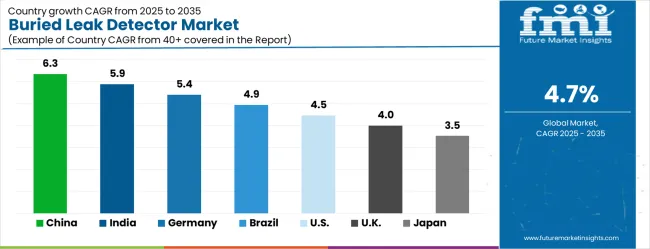
| Country | CAGR (2025-2035) |
|---|---|
| China | 6.3% |
| India | 5.9% |
| Germany | 5.4% |
| Brazil | 4.9% |
| United States | 4.5% |
| United Kingdom | 4.0% |
| Japan | 3.5% |
The buried leak detector market is growing rapidly, with China leading at a 6.3% CAGR through 2035, driven by strong infrastructure development and increasing adoption of smart city monitoring technologies in municipal utilities and industrial facilities. India follows at 5.9%, supported by rising infrastructure investment and growing emphasis on water conservation capabilities. Germany grows steadily at 5.4%, integrating advanced monitoring technologies into its established utility infrastructure. Brazil records 4.9%, emphasizing utility modernization and infrastructure monitoring enhancement initiatives. The United States shows solid growth at 4.5%, focusing on aging infrastructure replacement and regulatory compliance advancement. The United Kingdom demonstrates steady progress at 4.0%, maintaining established utility monitoring applications. Japan records 3.5% growth, concentrating on precision technology development and infrastructure optimization.
The report covers an in-depth analysis of 40+ countries top-performing countries are highlighted below.
Revenue from buried leak detectors in China is projected to exhibit the highest growth rate with a CAGR of 6.3% through 2035, driven by rapid expansion of urban infrastructure and increasing demand for advanced monitoring systems in water distribution and industrial pipeline networks. The country's growing smart city initiatives and expanding utility modernization programs are creating significant demand for reliable leak detection solutions. Major equipment manufacturers are establishing comprehensive distribution networks to support the increasing requirements of municipal utilities and industrial operators across urban markets.
Government infrastructure development initiatives are supporting establishment of modern monitoring systems and advanced detection equipment procurement, driving demand for buried leak detectors throughout major metropolitan areas. Municipal utility modernization programs are facilitating adoption of smart monitoring technologies that enhance system efficiency and water conservation standards across city networks.
Revenue from buried leak detectors in India is expanding at a CAGR of 5.9%, supported by increasing infrastructure investment and growing awareness of advanced monitoring system benefits. The country's expanding utility infrastructure and rising water conservation standards are driving demand for sophisticated detection solutions. Municipal utilities and industrial facilities are gradually implementing advanced monitoring systems to maintain operational standards and resource conservation objectives.
Infrastructure sector growth and utility development programs are creating opportunities for equipment suppliers that can support diverse monitoring requirements and operational specifications. Professional training and certification programs are building technical expertise among utility personnel, enabling effective utilization of leak detection technology that meets operational efficiency standards and conservation requirements.
Demand for buried leak detectors in Germany is projected to grow at a CAGR of 5.4%, supported by the country's emphasis on utility efficiency standards and monitoring technology adoption. German utility companies are implementing advanced detection systems that meet stringent performance requirements and regulatory specifications. The market is characterized by focus on detection accuracy, technological reliability, and compliance with comprehensive utility standards.
Utility industry investments are prioritizing advanced monitoring technologies that demonstrate superior performance and reliability while meeting German quality and environmental standards. Professional certification programs are ensuring comprehensive technical expertise among utility operators, enabling specialized detection system capabilities that support diverse infrastructure applications and regulatory requirements.
Revenue from buried leak detectors in Brazil is growing at a CAGR of 4.9%, driven by increasing utility modernization and growing recognition of advanced monitoring system advantages. The country's expanding infrastructure sector is gradually integrating sophisticated detection equipment to enhance operational efficiency and system reliability. Utility operators and industrial facilities are investing in leak detection technology to address evolving regulatory standards and operational requirements.
Utility modernization programs are facilitating adoption of advanced monitoring technologies that support comprehensive infrastructure protection capabilities across municipal and industrial regions. Professional development programs are enhancing technical capabilities among utility operators, enabling effective detection system utilization that meets evolving infrastructure standards and efficiency requirements.
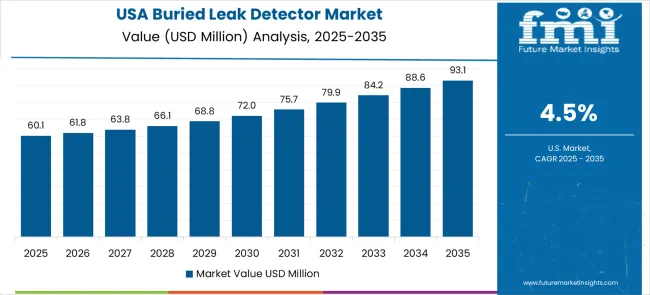
Demand for buried leak detectors in the USA is expanding at a CAGR of 4.5%, driven by established utility industries and growing emphasis on infrastructure renewal and regulatory compliance. Large utility companies and municipal systems are implementing comprehensive detection capabilities to serve diverse monitoring requirements. The market benefits from established distribution networks and professional training programs that support various infrastructure applications.
Infrastructure industry leadership is enabling standardized monitoring workflows across multiple utility systems, providing consistent detection quality and comprehensive coverage throughout regional markets. Professional development and certification programs are building specialized technical expertise among utility professionals, enabling effective detection system utilization that supports evolving infrastructure renewal requirements.
Demand for buried leak detectors in the UK is projected to grow at a CAGR of 4.0%, supported by established utility sectors and growing emphasis on monitoring capabilities. British utility companies and municipal systems are implementing detection equipment that meets industry quality standards and regulatory requirements. The market benefits from established utility infrastructure and comprehensive training programs for utility professionals.
Utility facility investments are prioritizing advanced detection technologies that support diverse infrastructure applications while maintaining established quality and regulatory standards. Professional development programs are building technical expertise among utility personnel, enabling specialized detection system operation capabilities that meet evolving monitoring requirements and quality standards.
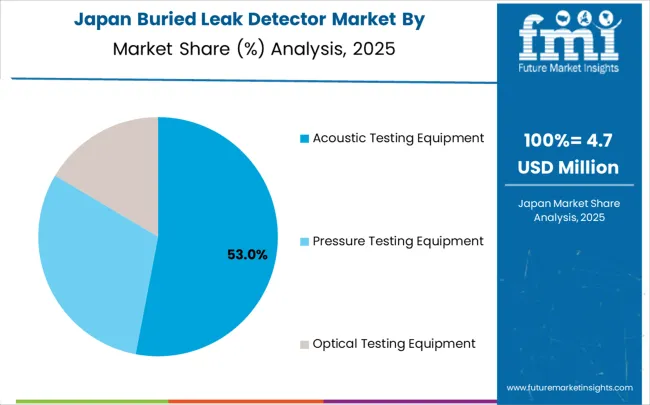
Revenue from buried leak detectors in Japan is growing at a CAGR of 3.5%, driven by the country's focus on precision technology innovation and infrastructure optimization applications. Japanese utility companies and technology firms are implementing advanced detection systems that demonstrate superior accuracy and monitoring efficiency. The market is characterized by emphasis on technological excellence, quality assurance, and integration with established infrastructure workflows.
Precision technology industry investments are prioritizing innovative detection solutions that combine advanced sensing with precision engineering while maintaining Japanese quality and reliability standards. Professional development programs are ensuring comprehensive technical expertise among utility operators, enabling specialized detection capabilities that support diverse infrastructure applications and quality requirements.
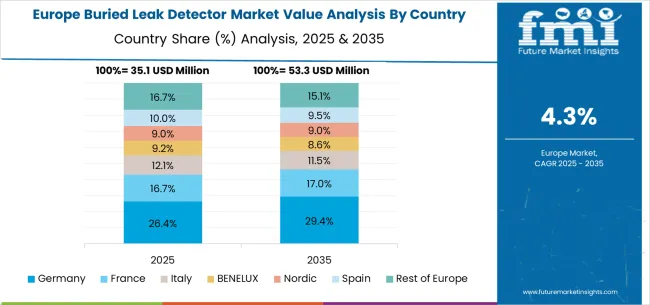
The buried leak detector market in Europe is forecast to expand from USD 35.9 million in 2025 to USD 55.4 million by 2035, registering a CAGR of 4.4%. Germany will remain the largest market, holding 28.0% share in 2025, easing to 27.5% by 2035, supported by strong utility infrastructure and advanced monitoring system adoption. The United Kingdom follows, rising from 22.5% in 2025 to 23.0% by 2035, driven by water utility modernization and regulatory compliance requirements. France is expected to grow from 17.0% to 17.5%, reflecting increased infrastructure investment and utility enhancement programs. Italy maintains growth at around 13.5% to 14.0%, supported by municipal utility modernization and infrastructure monitoring expansion, while Spain grows from 9.0% to 9.5% with expanding utility infrastructure and water conservation initiatives. Nordic markets rise from 6.0% to 6.5%, while the remainder of Europe hovers near 4.0%-2.0%, balancing emerging Eastern European infrastructure growth against established Western markets.
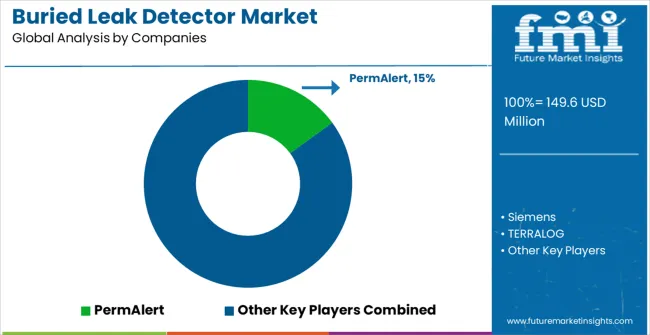
The Buried Leak Detector market is defined by competition among specialized detection equipment manufacturers, monitoring technology providers, and infrastructure solution companies. Companies are investing in advanced sensor development, detection algorithm optimization, system integration improvements, and comprehensive monitoring capabilities to deliver accurate, reliable, and cost-effective leak detection solutions. Strategic partnerships, technological innovation, and market expansion are central to strengthening product portfolios and market presence.
PermAlert offers comprehensive buried leak detector solutions with established sensing technology expertise and proven monitoring system capabilities. Siemens provides specialized infrastructure monitoring equipment with focus on industrial applications and system integration reliability. TERRALOG delivers advanced detection systems with emphasis on utility applications and operational efficiency. Delcon specializes in leak detection technologies with integrated monitoring and alert capabilities.
Ningbo Ruide Testing Instrument offers precision detection equipment with comprehensive testing capabilities and quality assurance systems. Perma-Pipe provides specialized pipeline monitoring solutions with focus on industrial applications and system reliability. EnTech Engineering delivers established detection technologies with advanced sensing and data analysis systems. Atmos International, Pure Technologies, TTK Leak Detection, Sensornet, Hifi Engineering, Nantong Universal Testing Instrument, PQWT, Dongguan Tuotian Intelligent Technology, Honeywell, ABB, Emerson, Schneider Electric, and Fluke offer specialized manufacturing expertise, detection reliability, and comprehensive product development across global and regional market segments.
| Item | Value |
|---|---|
| Quantitative Units | USD 149.6 million |
| Equipment Type | Acoustic Testing Equipment, Pressure Testing Equipment, Optical Testing Equipment |
| Application | Oil & Gas Pipelines, Water Distribution and Sewage Systems, Chemical Transport Pipelines, District Heating and Cooling, Fire Suppression Piping Networks |
| Regions Covered | North America, Europe, East Asia, South Asia & Pacific, Latin America, Middle East & Africa |
| Country Covered | China, India, Germany, Brazil, United States, United Kingdom, Japan, and 40+ countries |
| Key Companies Profiled | PermAlert, Siemens, TERRALOG, Delcon, Ningbo Ruide Testing Instrument, Perma-Pipe, EnTech Engineering, Atmos International, Pure Technologies, TTK Leak Detection, and others |
| Additional Attributes | Dollar sales by equipment type and application segment, regional demand trends across major markets, competitive landscape with established detection manufacturers and emerging technology providers, customer preferences for different detection methods and sensitivity levels, integration with infrastructure monitoring systems and utility protocols, innovations in detection sensitivity and alert system technologies, and adoption of IoT-enabled monitoring features with enhanced performance capabilities for improved infrastructure workflows. |
The global buried leak detector market is estimated to be valued at USD 149.6 million in 2025.
The market size for the buried leak detector market is projected to reach USD 236.9 million by 2035.
The buried leak detector market is expected to grow at a 4.7% CAGR between 2025 and 2035.
The key product types in buried leak detector market are acoustic testing equipment, pressure testing equipment and optical testing equipment.
In terms of application, water distribution and sewage systems segment to command 38.0% share in the buried leak detector market in 2025.






Our Research Products

The "Full Research Suite" delivers actionable market intel, deep dives on markets or technologies, so clients act faster, cut risk, and unlock growth.

The Leaderboard benchmarks and ranks top vendors, classifying them as Established Leaders, Leading Challengers, or Disruptors & Challengers.

Locates where complements amplify value and substitutes erode it, forecasting net impact by horizon

We deliver granular, decision-grade intel: market sizing, 5-year forecasts, pricing, adoption, usage, revenue, and operational KPIs—plus competitor tracking, regulation, and value chains—across 60 countries broadly.

Spot the shifts before they hit your P&L. We track inflection points, adoption curves, pricing moves, and ecosystem plays to show where demand is heading, why it is changing, and what to do next across high-growth markets and disruptive tech

Real-time reads of user behavior. We track shifting priorities, perceptions of today’s and next-gen services, and provider experience, then pace how fast tech moves from trial to adoption, blending buyer, consumer, and channel inputs with social signals (#WhySwitch, #UX).

Partner with our analyst team to build a custom report designed around your business priorities. From analysing market trends to assessing competitors or crafting bespoke datasets, we tailor insights to your needs.
Supplier Intelligence
Discovery & Profiling
Capacity & Footprint
Performance & Risk
Compliance & Governance
Commercial Readiness
Who Supplies Whom
Scorecards & Shortlists
Playbooks & Docs
Category Intelligence
Definition & Scope
Demand & Use Cases
Cost Drivers
Market Structure
Supply Chain Map
Trade & Policy
Operating Norms
Deliverables
Buyer Intelligence
Account Basics
Spend & Scope
Procurement Model
Vendor Requirements
Terms & Policies
Entry Strategy
Pain Points & Triggers
Outputs
Pricing Analysis
Benchmarks
Trends
Should-Cost
Indexation
Landed Cost
Commercial Terms
Deliverables
Brand Analysis
Positioning & Value Prop
Share & Presence
Customer Evidence
Go-to-Market
Digital & Reputation
Compliance & Trust
KPIs & Gaps
Outputs
Full Research Suite comprises of:
Market outlook & trends analysis
Interviews & case studies
Strategic recommendations
Vendor profiles & capabilities analysis
5-year forecasts
8 regions and 60+ country-level data splits
Market segment data splits
12 months of continuous data updates
DELIVERED AS:
PDF EXCEL ONLINE
Vacuum Leak Detectors Market Size and Share Forecast Outlook 2025 to 2035
Roof Water Leak Detector Market Size and Share Forecast Outlook 2025 to 2035
Global Gas Leak Detectors Market
Refrigeration Leak Detector Market Growth - Trends & Forecast 2025 to 2035
Leak Detection Equipment Market Size and Share Forecast Outlook 2025 to 2035
Leak Detection Market Size and Share Forecast Outlook 2025 to 2035
Leak Detection Dye Market Trends & Demand 2025 to 2035
An Analysis of the Leak testing Machine Market by Detectors and Sensors Hardware Type through 2035
Market Share Distribution Among Leak Testing Machine Providers
Leak testing Machine Market
Air Leak Testing Market Size and Share Forecast Outlook 2025 to 2035
XEDS Detectors Market Size and Share Forecast Outlook 2025 to 2035
Water Leak Sensors Market Size and Share Forecast Outlook 2025 to 2035
Radar Detectors Market Size and Share Forecast Outlook 2025 to 2035
Water Leak Detection System for Server Rooms and Data Centers Market Size and Share Forecast Outlook 2025 to 2035
Water Leakage Tester Market Size and Share Forecast Outlook 2025 to 2035
Flame Detector Market Size and Share Forecast Outlook 2025 to 2035
Smoke Detector Market Insights – Growth & Forecast through 2034
Cable Detector Market
AI-Powered Age Detection – Future of Digital Verification

Thank you!
You will receive an email from our Business Development Manager. Please be sure to check your SPAM/JUNK folder too.
Chat With
MaRIA